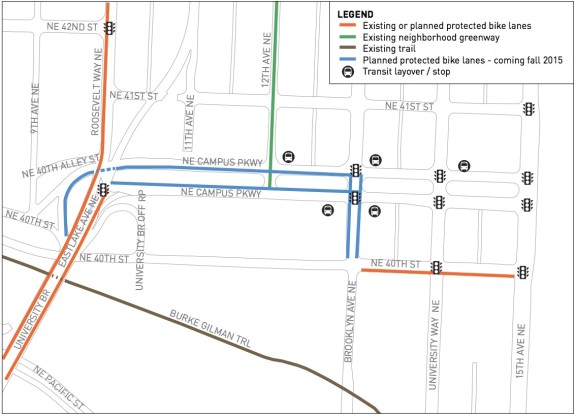 The city has started laying out the spray-paint outlines for new protected bike lanes on NE Campus Parkway and one block of Brooklyn Ave NE in the U District. The project should be complete by the end of September.
The city has started laying out the spray-paint outlines for new protected bike lanes on NE Campus Parkway and one block of Brooklyn Ave NE in the U District. The project should be complete by the end of September.
The new bike lanes will connect much of UW campus and the U District to the bike lanes on the University Bridge, which are also due for some significant upgrades as part of the Roosevelt repaving project.
The road will still have two lanes in each direction despite having relatively low traffic levels. But they will be skinnier, which should slow speeds a bit and make space for five-foot bike lanes with two feet of buffer and plastic reflective posts. The new bike lanes will be aligned next to the median, sort of like on Ravenna Boulevard.
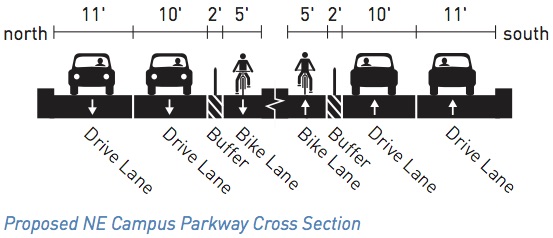 The project will also add protected bike lanes to one block of Brooklyn Ave NE south of Campus Parkway. This stretch currently has a paint-only uphill bike lane and sharrows downhill, so this is a significant upgrade.
The project will also add protected bike lanes to one block of Brooklyn Ave NE south of Campus Parkway. This stretch currently has a paint-only uphill bike lane and sharrows downhill, so this is a significant upgrade.
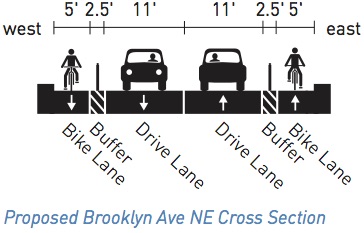 Unfortunately, the bike lanes will only go for a block, stopping one block short of the Burke-Gilman Trail. Looking at the map above shows you just how close we are to finally making a solid connection, but a series of maddening mistakes in planning by both the city and UW mean this connection will remain incomplete.
Unfortunately, the bike lanes will only go for a block, stopping one block short of the Burke-Gilman Trail. Looking at the map above shows you just how close we are to finally making a solid connection, but a series of maddening mistakes in planning by both the city and UW mean this connection will remain incomplete.
I asked SDOT why they are stopping short. Their response:
The Brooklyn protected bike lanes will not extend south of NE 40th Street to connect with the Burke Gilman Trail because the roadway on this part of Brooklyn is too narrow to accommodate them. The roadway is only 25 feet wide. Instead, this section of Brooklyn has a northbound, regular bike lane, and for southbound bicyclists there are sharrow pavement markings indicating that bicyclists share the road with motor vehicles.
Sharrows…
 But people who look very closely at the sidewalk on this one-block missing link may notice something surprising: It’s not actually a sidewalk.
But people who look very closely at the sidewalk on this one-block missing link may notice something surprising: It’s not actually a sidewalk.
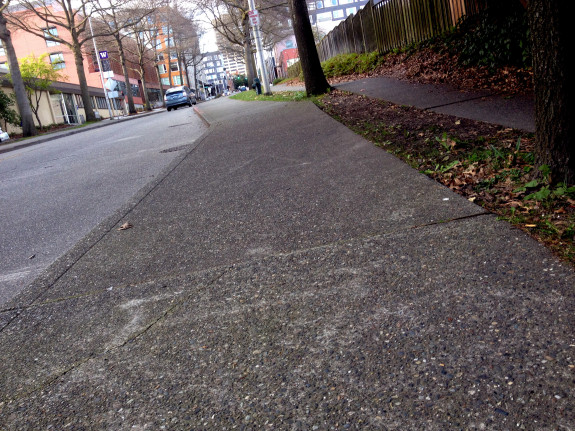 An extremely faded bike marking shows that the area left of the skinny planting strip is actually a decades-old and apparently unsuccessful attempt at creating a separated bike lane.
An extremely faded bike marking shows that the area left of the skinny planting strip is actually a decades-old and apparently unsuccessful attempt at creating a separated bike lane.
This lane does not appear on any of Seattle’s bike maps, and even city workers didn’t seem to notice it’s a bike lane and not a sidewalk before installing sign poles in the middle of it.
 Worse yet, a more modern development project clearly didn’t get the memo about the bike lanes either and turned part of the downhill lane into planting area for half a block:
Worse yet, a more modern development project clearly didn’t get the memo about the bike lanes either and turned part of the downhill lane into planting area for half a block:
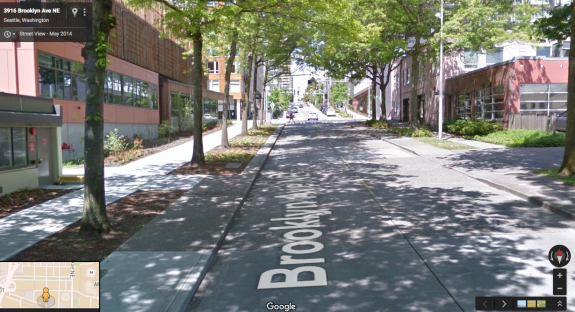
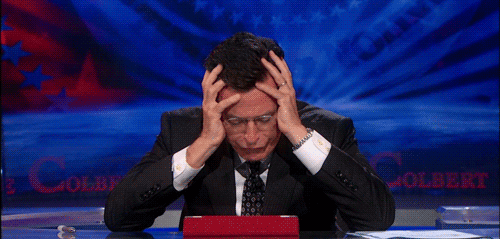 Maybe it’s time to restore these lanes. Unfortunately, that’s gonna take some work and funding, especially for the downhill lane.
Maybe it’s time to restore these lanes. Unfortunately, that’s gonna take some work and funding, especially for the downhill lane.
But getting the uphill lane back in working order might only require moving the signs out of the path, laying down some green paint and, most importantly, redesigning the curb cuts at NE 40th Street and the transition at the Burke-Gilman Trail (which was recently redesigned, but leaves a gap in the connection to the old bike lane).
This route will likely become the primary way for people to get from westbound on the Burke-Gilman Trail to the University Bridge, the 12th Ave neighborhood Greenway and the under-construction Brooklyn light rail station. Those are major regional bike connections. Stopping one tantalizing block from actually completing a protected bike route connection is maddening.
And this adds to another maddening missing link: A recently-completed UW building at 12th and Campus Parkway created a new pedestrian connection to the Burke-Gilman Trail, but the ramp is designed as an ADA ramp far below the standards for a safe bike path. That’s right, a brand new connection between one of the busiest trails in the nation and one of the densest neighborhoods in the city does not have a proper bike path. (UPDATE: For more on that project, see this Urbanist story).
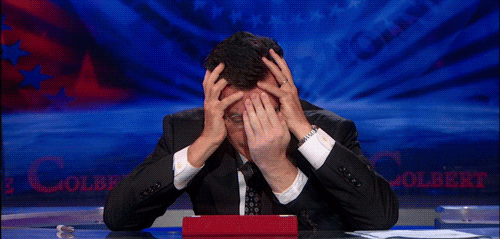 So great on the city for the Campus Parkway bike lanes, which are vital. But the work isn’t done yet. Despite all these facepalms, we can still create safe and direct bike connections in this area.
So great on the city for the Campus Parkway bike lanes, which are vital. But the work isn’t done yet. Despite all these facepalms, we can still create safe and direct bike connections in this area.












Comments
39 responses to “Campus Parkway protected bike lanes will come tantalizingly close to connecting U Bridge, Burke-Gilman”
It’s been my observation that vehicular traffic on this one block “missing link” is extremely light. Is the lack of a protected bike lane here a real problem? Is there enough traffic that bikes need “protection”? Or is it just that the system of protected bike lanes should be complete as a matter of principle, regardless of actual need?
Light traffic has a threshod: 1000 cars/day. If it doesn’t meet that, can traffic be diverted for this block? Make it one-way away from the trail with two-way bike traffic? (I don’t live in Seattle, just suggesting options)
It is needed, depending on who you are.
You might be fine biking uphill on an arterial street with nothing but sharrow markings, but we are trying to create a bike network that reaches beyond the people who can or want to bike in traffic. What about people biking with kids? Or what about kids biking on their own? What about people who want to try cycling, but are nervous about mixing with traffic?
We already have a bike route network for people who don’t mind biking in traffic, and it’s not good enough for most people.
Here we have a chance to connect our premier separated bike route (the Burke) to improved bike lanes across the the University Bridge and a neighborhood greenway (though 12th Ave still needs a lot of work to become an actually safe and inviting neighborhood greenway). We have to complete these connections when we have the chance.
Tom – Where would someone be biking uphill on an arterial street? Brooklyn has an uphill bike lane between Pacific and 40th. It’s a relatively new striping so it doesn’t appear in your raised bike lane photo or on Google Street View.
In terms of the downhill direction, I agree that it would be nice to have a protected or even standard bike lane, but I’m also not terribly opposed to the existing treatment (downhill sharrow) combined with the planned future condition (stop sign at a raised crossing of the Burke-Gilman Trail). Maybe a standard or protected bike lane would be more comfortable for this single block? Given the amount of downhill bike traffic that wants to turn left onto the Trail to reach points east, I think you could also argue that a shared street is a reasonable approach, especially given that car volumes on this block are relatively low (no, I don’t have the numbers. Yes, I suspect they’re over 1,000).
As for utilizing the uphill protected bike lane, there are a few issues that detract from its usability and make it understandable – at least to me – that the City would want to separate it from the Campus Parkway project, which really is distinct from improvements to Brooklyn. For starters, when the City recently reconstructed the BGT crossing of Brooklyn, they left a sliver of the uphill sidewalk bike lane unpaved (https://twitter.com/NEGreenways/status/640045978494484480). That’s probably a mistake on the part of the City or their contractor, but that doesn’t make it any less of a drawback. Additionally, because it’s an old installation, the sidewalk bike lane drops down to the level of the roadway at a driveway to the north, between the BGT and 40th. Ideally, you’d want the bike lane to stay at sidewalk level, because dropping down to the street level encourages drivers to take the driveway turn at speed. This is one of the design features that caused conventional “sidepaths” to fall out of favor. Lastly, at the intersection of 40th, the existing “STOP” sign is directly in the path that a bicyclist would take to access the curb ramp. None of these are insurmountable, but for a project on a short implementation timeline (Campus Parkway) you can sort of understand the City wanting to limit scope.
As for the downhill sidewalk bike lane, I’m afraid that’s a more deliberate change in the use of the space. Per DPD’s U District Green Streets Concept Plan, “Preserve existing trees and use outer sidewalk along west side for landscaping” (p. 21). The Preferred Section graphic is more clear on the design intent. I’m not saying I favor this design, but it’s not fair to call the new development’s (Ethnic Cultural Center) landscaping changes a mistake when the design is consistent with the City’s concept plan.
I’ll just say this – it baffles me that people would argue *against* connectivity. Especially with such an overwhelmingly easy missed opportunity as the case in point.
Not arguing against connectivity, Richard, but rather in favor of maximizing limited resources. In my neighborhood, the City spent $100K or more on a Greenway on neighborhood side streets that don’t see 300 cars/day. Too bad that money wasn’t spent somewhere it was really needed. We should be spending public dollars where they yield tangible benefits, not just where they “feel good.”
Richard – I’m not arguing against connectivity. I’m just pointing out that there are a lot of constraints on the single block in question, running the spectrum from planning level (design guidance in the City’s Green Streets Concept Plan) to physical infrastructure (existing roadway width, poor design of the existing sidewalk bike lanes, etc.). When I look closely at each of these trade-offs, the appropriate design treatment is not overwhelmingly easy.
David,
You’re right, I totally forgot about the new uphill bike lane on that block of Brooklyn. I’ll update the post to note it, and I take back my comment about biking uphill with only sharrows. Apologies for the confusing, everyone.
And I’m sure the landscaping in front of the center is consistent with plans for more greenery on this concrete-heavy street. The “mistake” was in accounting for the need for a bike lane, too. I don’t care if it’s in the existing “bike lane” space or not, but it needs to be somewhere. If a plan takes away bike space, leaving no room for a bike lane on a major bike route, then that is a mistake in my book.
Either that or one of the interesting ideas presented here, like making this block one-way for motor vehicles or otherwise creating a truly low-traffic stretch using diverters (maybe at Campus Parkway?).
But leaving the traffic flow as is (especially with traffic demand likely picking up after the station opens), having only sharrows downhill can’t be the final solution.
And yes, I am super excited about the raised intersection concept UW plans. Stop signs there would definitely help. In fact, could they be installed today?
Oh, I’m sure there are *great* reasons not to complete these connections. There always are.
One note about the ramp between the 12th Ave Greenway and the Burke; there’s a doorway next to the ramp. Right now the building is closed, but once it’s open getting doored will be a real risk for people using the ramp.
https://twitter.com/NEGreenways/status/642519837185474560
I’m confused. I thought Campus Parkway runs East/West not North/South, but the graphic above indicates it’s the latter. If that’s the case then why have the protected bike lane on the street near the median for the section that runs toward the UW campus? Bikes travel north on the Univ. Bridge and then have to cross in front of traffic (both from behind and the cars that turn left(southbound) from Roosevelt) to get over near the median to access the protected bike lane? Am I understanding this correctly?
The “north” and “south” markings on the layout graphics are confusing. They mark with way you would go if you turned that way, not the direction of travel pictured. So Campus Parkway is (for the most part) east-west. The map is more clear on the location of the routes.
I’m kind of a protected bike lane skeptic. I’ve ridden through the U district often over the years, and I’ve never had much problem interacting with cars in this area. I’m having trouble getting very excited about this project. I know the arguments for protected bike lanes. They make us safer and encourage more folks to use bicycles for transportation. We have installed a number of PBLs in recent years (e.g., Linden Street, Broadway, Second Ave.). Do we have any data yet to show that these routes are in fact safer and have in fact increased the number of people bicycling? I personally don’t care for PBLs, but if they do in fact achieve these goals, then I’m willing to say “Yay PBLs!”. I love to see a data rich article on our experience to date with protected bike lanes.
We have data showing that reluctant users are more willing to use protected bike lanes.
We have data showing that increased cycling adoption is the single most heavily correlated data point to rate of bike/car crashes.
on that alone PBLs are worth it unless there is a compelling reason *not* to.
I’ve seen data where people say they would be more willing to rely on bicycles for transportation if we built protected bicycle lanes. Now that we have some PBLs, it’s worth asking if these people really did use them. If so, yay, we did the right thing. If not, then why aren’t they using them. Right now I feel like we’re building bicycle infrastructure for people who don’t currently ride bicycles. This is worthwhile if it does in fact increase the number of people using bicycles. I’m wondering if it really has. Do we have any data on the currently installed PBLs that suggests a trend?
Rich Knox: we don’t have a *network* of PBLs. Random lanes here and there that don’t connect to anything isn’t going to increase ridership. In fact, it may have the opposite effect as people riding bikes become frustrated as they are unceremoniously dumped into vehicular traffic (see the S end of the 2nd ave lane for a prime example). Until the PBLs connect to places people want to go, they’re just a demonstration project.
rob_kp: exactly! My wife absolutely loves bikes as transportation. She has a great bike, likes riding it, etc. Traveling to work by bike for her would be almost the same amount of time it takes her on the bus, and because of parking, probably less time than driving.
And yet she almost never travels by bike. She knows the stats, she knows it’s not really unsafe, but she just can’t get past her reluctance to bike in traffic, and there’s simply no possible way to get to where she’s going without doing so. And we effectively live *ON* the Broadway bikeway!!
We’ve got all these little islands of great stuff, and just like the example Tom’s giving, they JUST. DON’T. CONNECT.
And until they do, they simply don’t really matter to the people they’re supposed to be helping.
We MUST have connectivity if we want to attract people like her.
I’ve noticed the faded bike paint on the Brooklyn sidewalks, too, but unfortunately these paths just aren’t suitable for carrying any significant amount of bike traffic, especially downhill. The sight lines are awful (at Campus Parkway, at the east-side driveway north of the Burke, and at the Burke itself), and they’re narrow, with fall hazards immediately on both sides, and traffic immediately on one. The northbound side is probably as usable as it’s ever been, and might be OK for some slow riders and children. We’re better off with the southbound side broken up by planters and obstructed with signs.
There’s a reason the vehicular cycling crowd hates bike infrastructure: it’s because they came of age while this was the sort of bike infrastructure being built.
I’m not sure I understand how the intersections will work. If I’m headed east on the new bike lane on Campus Parkway, and I want to go south on Brooklyn to connect to the Burke-Gilman, what do I do? I’m in the left-most lane and I need to make a right turn across traffic into the right-most lane on Brooklyn? The same question applies to northbound bikes on Brooklyn wanting to go west on Campus Pkwy — they’re turning from the right-most lane across traffic into the left-most westbound lane?
Presumably there will need to be new traffic signals installed to make this feasible, but it just seems like asking for trouble, having cyclists turn across traffic coming from behind them (even if they have a green arrow or whatever). Or maybe they’ll make it a two-stage turn, where you have to jog first in the opposite direction you want to turn, and then turn 180 degrees in a green bike box and wait for the light?
Matthew’s comment gets at the reason(s) why I’m confused by the map and more importantly, confused by the proposed design. The most obvious eastbound route (on NE Campus Pkway) is going from the U Bridge to the Burke Gilman or to the UW Campus proper. So you’re supposed to cross two lanes of traffic to get into the protected bike lane next to the median? Then turn back across those same two lanes to access the Burke, or the protected bike lane on 40th that leads to the UW, by turning right onto Brooklyn? That makes no sense. Put the eastbound bike lane on the right (south) side of NE Campus Parkway to connect it to the northbound bike lane from Roosevelt so it’s one continuous lane.
Hey Matthew – There are green turn boxes to facilitate the turns you’re talking about, and dashed bike lanes that continue through the intersections to guide bicyclists into the continuing protected bike lanes. The City didn’t post any of their design documents on the project page, but the crossing improvements were included in the 90% design set that I saw.
It’s pretty confusing if you haven’t seen the plans. This if from the 90% plans:
https://twitter.com/NEGreenways/status/646052670440996864
The green is the current markings on the street, the red is what will be installed. Those red boxes in the intersection are for people turning.
If you’re heading north on Brooklyn and want to turn left, you’ll first turn to the right to wait in the bike box. By waiting there, you’re out of the path of people continuing straight.
If you’re heading east on Campus Pkwy and want to turn right, you’ll first turn left to wait in the bike box. You’ll be waiting in front of stopped Brooklyn Ave traffic for the light to change. Once it turns green, you’ll then cross the two lanes of Campus Pkwy to enter the Brooklyn Ave bike lane.
Of course, vehicular cyclists or people in a rush going eastbound on Campus Pkwy would probably just take a travel lane and make a direct right onto Brooklyn.
As a vehicular cyclist I dislike most protected bike lanes because as built so far in Seattle they are often bloody dangerous. Northbound downhill on Dexter north of Denny you’ll find me in the general traffic lane — I’ve had too many close calls in the “safe” curbside lane. The 2nd Ave lanes are an improvement only because the original was so bad.
This project reminds me of the first phase of Link stopping a mile from the airport, one of its primary destinations. Why can’t this region get projects right the first time?
The confusion is a big problem. Daily users in sunlight might not have as much trouble as infrequent visitors to campus. That’s the spot where I fell and broke my arm last year (going zero miles an hour) while looking for the connection on a dark and stormy night.
What confuses me more than the across-two-lanes turns is how the protected connection onto the southbound bridge lane will be handled. The merge onto the U-Bridge is an unfortunate combination of two lanes merging (Campus Prkwy and 40th) slowly then immediately trying to match speed with drivers going 40mph down Roosevelt. Driving there is hard, making the merge is hard, effectively adding another slow merging lane is going to be harder. Currently I’m a fan of using 40th or the Burke to go under the bridge, working my way up 40th on the street or sidewalk, and then getting into the southbound bridge lane to the right of that merge-mess. I’m skeptical this will be an improvement over that.
The merge onto the bridge totally skips Roosevelt traffic. There’s still an unfortunate merge of Campus Pkwy and 40th (which this project will modify a bit), but one bikes directly from Campus Pkwy into the University Bridge bike lane without interacting with 40mph Roosevelt traffic at all.
Wow, this block of Brooklyn sure is getting a lot of attention… when the much more interesting question is how the westbound connection to the U Bridge is actually going to work! The mess of merge ramps entering southbound Eastlake toward the bridge is a big challenge today from every direction, and I’m not sure how they plan to get cyclists starting on the left across that mess and to a bike lane on the right.
Today the best way to get to the bridge from the Burke (whether you’re coming from the east or the west) is probably NE 40th St (on the west side of the bridge). I’m not sure a Campus Parkway upgrade actually changes this. If you take NE 40th you have to go through a somewhat confusing 5-way stop sign and ride in mixed (but not especially heavy) traffic up a hill on 40th. From there you don’t have to cross any more traffic to get to the bike lane on the bridge. By comparison, going by Brooklyn and Campus Parkway you’ll go through a much easier all-way stop at Brooklyn/Lincoln, a two-stage turn at Brooklyn/Campus, and then you’ll have to cross cars entering from Campus Parkway and 40th somehow. If we focused on improving 40th for bikes heading to the bridge, there’s enough room to build a climbing lane all the way to the bridge, and there’s no cross traffic from the right between the stop sign and the bridge, so designing physical separation would be relatively easy.
The best way to get from the bridge to the Burke (going either direction) is the cloverleaf ramp down to (lower) 40th. This project does nothing to change that; taking the ramp to Campus Parkway involves more complicated and busy intersections no matter how you slice it. I don’t know exactly how you’d improve the cloverleaf ramp… maybe a left-side bike lane starting after the exiting cars have merged across? The connection to a median bike lane on Campus Parkway would have to involve turning right after two sets of exiting cars have merged across, and you’d still have arterial traffic and a two-phase turn between yourself and the Burke.
For connections between campus and the Burke to the west, Lincoln Way is going to be more attractive for almost everyone, right? One thing Lincoln Way is not good at is connecting to the 12th Ave Greenway. On the other hand, turns between a median bike lane on Campus Parkway and 12th at an unsignalized intersection won’t be easy…
It seems like the real value of this might be connecting the Burke (and Lincoln/lower 40th) to the 12th Ave Greenway and the bike lane on 11th. Although even then it’s not perfect unless there’s an easy way to cross westbound Campus Parkway to the greenway.
Once again, I find myself agreeing with Al. When this project is complete, the existing ways of getting from bridge to Burke (cloverleaf) and vice versa (40th) will still be superior. So, to the extent that’s the reason for this project, it’s a rather conspicuous waste of resources.
If there’s one thing we should have learned from the numerous Burke closures, Roosevelt bike lane (and sidewalk) closures, etc, it’s that we need multiple safe, parallel routes! We’d never claim that having a sidewalk on only one side of the street is okay, or only one arterial for drivers..
Sure, and having lots of good bike routes helps people that aren’t familiar with the hard to find ones that exist… except that the situation here for making turns will be unfamiliar to most people, too.
And of course we need bike access on arterials for access to buildings along them… except that median bike lanes don’t work that well for local access. Obviously curb-side would be even worse on this street because of all the bus stops, but the median certainly has this disadvantage for local movement.
This was driven more by a desire to do something on Campus Parkway than a desire to improve bike connections. This is common enough in Seattle. We have a lot of decaying and dysfunctional streets, and the city is most interested in fixing the major car routes because lots of car traffic really exposes the problems. If we can get reasonably well-designed bike lanes along with these sorts of fixes that’s fine for what it’s worth. From a bike perspective, we’ll improve bike connections a lot more if we implement projects whose actual purpose is improving bike connections.
Andres, You describe this new configuration as a “safe” parallel route. I’m convinced that this new route will be slow and inconvenient given the need to make elaborate two-stage lefts using the provided bike boxes (to the extent anyone even bothers). But I question whether it will actually be “safe.” The merging issues getting onto the bridge are an obvious concern, but there are also problems for anyone not making the turn between Campus Parkway and Brooklyn. If you continue straight east on Campus Parkway, without turning at Brooklyn, you can be left hooked. If you stay on the left and continue straight eastbound at the Ave, you can be left hooked again. Same applies to people riding westbound on Campus Parkway to access the protected lane. They will need to merge across traffic to access the left side and then not get left-hooked crossing Brooklyn. I recognize that you can be right-hooked too. But I think the novelty of having cyclists on the left is going to cause confusion. That’s the problem with these elaborate one-off designs. They make it look like the city is bending over backward for cyclists, and I’m concerned that this particular set-up is going to be too inconvenient to see much use. There’s no disclaimer saying “we did this because it was easy because the street was being redone anyway.”
@ODB, when I call it safe, I’m going by my experience with the Ravenna Blvd buffered bike lane (which is on the left side, and feels pretty safe – except for a few poorly-designed locations).
It’s clearly not ideal if you’re continuing on Campus Pkwy. For people who find the left-side thing inconvenient, I expect they’ll just take the lane. That’s what I do on NE 40th, where switching to the wrong side to access the 2-way PBL for a block isn’t worth the hassle. I’m in agreement with Josh that there should be some kind of notification to motorists that bikes have a right to use the general travel lane ( https://twitter.com/j_putnam/status/646112638464753665 ).
When I want to go north from the Burke coming from the east I always take the bike lane on University Way rather than on Brooklyn, and get over to the 12th greenway on 41st. The intersection of the Burke and University Way is at the corner rather than half-way through the block and it’s flat – the approach from the Burke from the east onto Brooklyn is downhill. I suppose I could zigzag from University to 40th to Brooklyn and to Campus Parkway to get to 12th.
I agree with Al about the utility of the Campus Parkway route to the University Bridge. Improving the approach from 40th would be great.
Here’s the thing about the 90% plans that I have – they assume that the Roosevelt repaving project (with associated PBL) is done. Until then, the connection to the bridge is going to continue to be weird. I’m sure the connection will be closed for construction for a while, as well. Hopefully that part happens early in the repaving project!
The repaving project was supposed to have started already, but at this point it’s been pushed back to “early 2016”. Meanwhile, the Campus Pkwy PBL project is happening now.
Late to the party, but this post (and graphic) does not seem to recognize that there is a really nice 2-way protected bikeway along 40th between 7th and Brooklyn: people heading west on the Burke from this area actually have a really nice connection from the planned trail. Eastbound is the main problem. Thanks for the post!
I’d like to see more signage and perhaps better infrastructure in directing cyclists from south campus to the southbound bike lane on U-Bridge. In fairer weather, I encounter a wrong-way cyclist going down the northbound bike lane on the bridge at least once a month. It’s really dangerous.
[…] of trail will remain open for local access, but won’t work for through-travel. The city also installed new bike lanes on Campus Parkway and Brooklyn that could help better connect the detour route to […]
[…] Seattle Bike Blog had this to say about the problem: […]